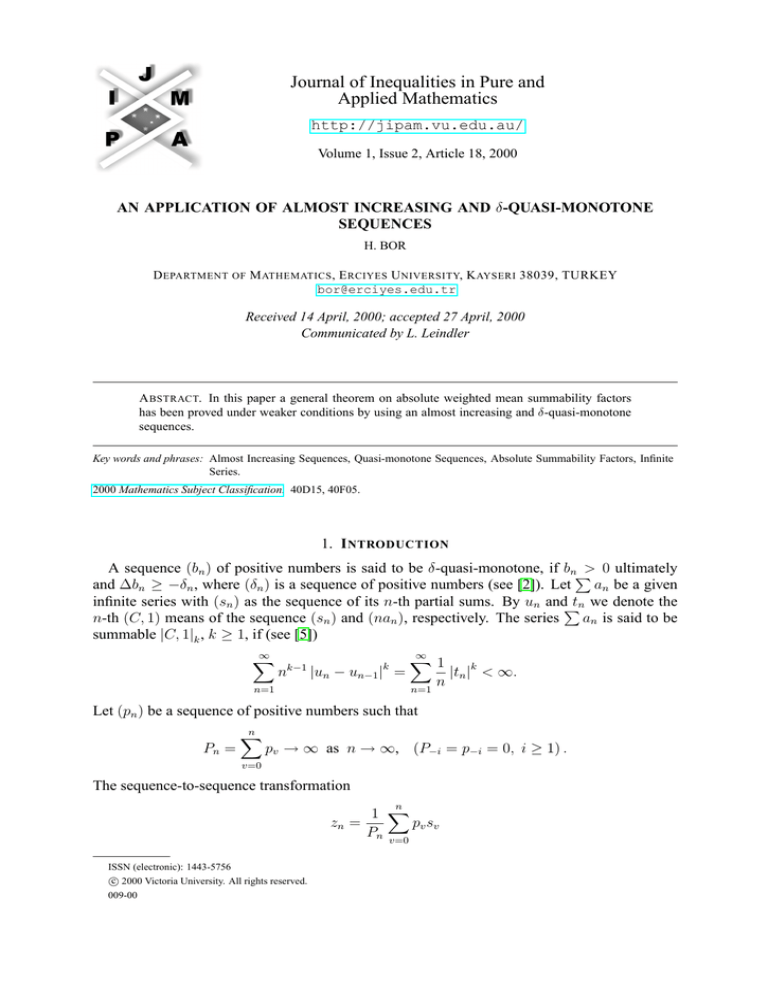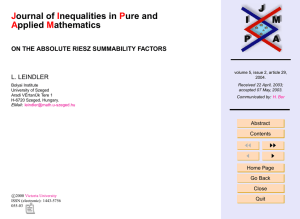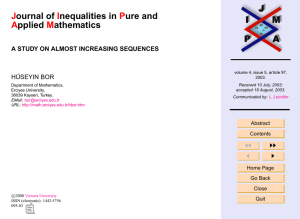
Journal of Inequalities in Pure and
Applied Mathematics
http://jipam.vu.edu.au/
Volume 1, Issue 2, Article 18, 2000
AN APPLICATION OF ALMOST INCREASING AND δ-QUASI-MONOTONE
SEQUENCES
H. BOR
D EPARTMENT OF M ATHEMATICS , E RCIYES U NIVERSITY, K AYSERI 38039, TURKEY
bor@erciyes.edu.tr
Received 14 April, 2000; accepted 27 April, 2000
Communicated by L. Leindler
A BSTRACT. In this paper a general theorem on absolute weighted mean summability factors
has been proved under weaker conditions by using an almost increasing and δ-quasi-monotone
sequences.
Key words and phrases: Almost Increasing Sequences, Quasi-monotone Sequences, Absolute Summability Factors, Infinite
Series.
2000 Mathematics Subject Classification. 40D15, 40F05.
1. I NTRODUCTION
A sequence (bn ) of positive numbers is said to be δ-quasi-monotone, if bnP
> 0 ultimately
and ∆bn ≥ −δn , where (δn ) is a sequence of positive numbers (see [2]). Let
an be a given
infinite series with (sn ) as the sequence of its n-th partial sums. By un andPtn we denote the
n-th (C, 1) means of the sequence (sn ) and (nan ), respectively. The series
an is said to be
summable |C, 1|k , k ≥ 1, if (see [5])
∞
X
n
k−1
n=1
∞
X
1
|tn |k < ∞.
|un − un−1 | =
n
n=1
k
Let (pn ) be a sequence of positive numbers such that
Pn =
n
X
pv → ∞ as n → ∞, (P−i = p−i = 0, i ≥ 1) .
v=0
The sequence-to-sequence transformation
n
1 X
zn =
p v sv
Pn v=0
ISSN (electronic): 1443-5756
c 2000 Victoria University. All rights reserved.
009-00
2
H. B OR
defines the sequence (zn ) of the N̄ , pn mean of the sequence (sn ) generated
by the sequence
P
of coefficients (pn ) (see [6]). The series
an is said to be summable N̄ , pn k , k ≥ 1, if (see
[3])
k−1
∞ X
Pn
|zn − zn−1 |k < ∞.
p
n
n=1
In the special case pn = 1 for all values of n (resp. k = 1), then N̄ , pn k summability
is
1
N̄ , pn ) summability. Also if we take pn =
, then N̄ , pn k
the same as |C, 1|k (resp.
n+1
1
summability reduces to N̄ , n+1 k summability.
Mazhar [7] has proved the following theorem for summability factors by using δ-quasimonotone sequences.
Theorem 1.1. Let λn → 0 as n → ∞. Suppose
that there exists
a sequence of numbers
P
P
(An ) such that it is δ-quasi-monotone with
nδn log n < ∞,
An log n is convergent and
|∆λn | ≤ |An | for all n. If
m
X
1
|tn |k = O (log m) as m → ∞,
n
n=1
P
an λn is summable |C, 1|k , k ≥ 1.
Later on Bor [4] generalized Theorem 1.1 for a N̄ , pn k summability method in the following
form.
then the series
Theorem 1.2. Let λn → 0 as n → ∞ and let (pn ) be a sequence of positive numbers such that
Pn = O (npn ) as n → ∞.
Suppose
that there
P
P exists a sequence of numbers (An ) such that it is δ-quasi-monotone with
nδn Xn < ∞, An Xn is convergent and |∆λn | ≤ |An | for all n. If
m
X
pn
|tn |k = O (Xm ) as m → ∞,
P
n=1 n
where (Xn ) is a positive increasing sequence, then the series
k ≥ 1.
P
an λn is summable N̄ , pn k ,
It should be noted that if we take Xn = log n and pn = 1 for all values of n in Theorem 1.2,
then we get Theorem 1.1.
2. T HE M AIN R ESULT.
1
Due to the restriction Pn = O (npn ) on (pn ) , no result for pn = n+1
can be deduced from
Theorem 1.2. Therefore the aim of this paper is to prove Theorem 1.2 under weaker conditions
and in a more general form without this condition. For this we need the concept of almost
increasing sequence. A positive sequence (dn ) is said to be almost increasing if there exists a
positive increasing sequence (cn ) and two positive constants A and B such that Acn ≤ dn ≤
Bcn (see [1]). Obviously, every increasing sequence is almost increasing but the converse need
n
not be true as can be seen from the example dn = ne(−1) . Since (Xn ) is increasing in Theorem
1.2, we are weakening the hypotheses of the theorem by replacing the increasing sequence with
an almost increasing sequence.
Now, we shall prove the following theorem.
J. Inequal. Pure and Appl. Math., 1(2) Art. 18, 2000
http://jipam.vu.edu.au/
A N A PPLICATION OF A LMOST I NCREASING AND δ-Q UASI -M ONOTONE S EQUENCES
3
Theorem 2.1. Let (Xn ) be an almost increasing sequence and λn → 0 as n → ∞.
P Suppose that
there
P exists a sequence of numbers (An ) such that it is δ-quasi-monotone with nδn Xn < ∞,
An Xn is convergent and |∆λn | ≤ |An | for all n. If
m
X
1
|λn | = O (1) ,
n
n=1
m
X
1
|tn |k = O (Xm ) as m → ∞
n
n=1
and
m
X
pn
|tn |k = O (Xm ) as m → ∞,
P
n
n=1
P
then the series an λn is summable N̄ , pn k , k ≥ 1.
We need the following lemmas for the proof of our theorem.
Lemma 2.2. Under the conditions of the theorem, we have
|λn | Xn = O (1) as n → ∞.
Proof. Since λn → 0 as n → ∞, we have that
∞
∞
∞
∞
X
X
X
X
|λn | Xn = Xn ∆λv ≤ Xn
|∆λv | ≤
Xv |∆λv | ≤
Xv |Av | < ∞.
v=n
v=n
v=0
v=0
Hence |λn | Xn = O (1) as n → ∞.
Lemma 2.3. LetP
(Xn ) be an almost increasing sequence. If (An ) is δ-quasi-monotone with
P
nδn Xn < ∞, An Xn is convergent, then
nAn Xn = O (1) ,
∞
X
nXn |∆An | < ∞.
n=1
The proof of Lemma 2.3 is similar to the proof of Theorem 1 and Theorem 2 of Boas [2, case
γ = 1], and hence is omitted.
3. P ROOF OF THE T HEOREM
P
Proof of Theorem 2.1. Let (Tn ) denote the N̄ , pn mean of the series an λn . Then, by definition and changing the order of summation, we have
n
v
n
1 X X
1 X
Tn =
pv
ai λ i =
(Pn − Pv−1 ) av λv .
Pn v=0 i=0
Pn v=0
Then, for n ≥ 1, we have
Tn − Tn−1
n
n
pn X
pn X Pv−1 λv
=
Pv−1 av λv =
vav .
Pn Pn−1 v=1
Pn Pn−1 v=1
v
J. Inequal. Pure and Appl. Math., 1(2) Art. 18, 2000
http://jipam.vu.edu.au/
4
H. B OR
By Abel’s transformation, we get
Tn − Tn−1
n−1
n−1
n+1
pn X
v+1
pn X
v+1
=
pn tn λn −
pv tv λv
+
Pv tv ∆λv
nPn
Pn Pn−1 v=1
v
Pn Pn−1 v=1
v
n−1
pn X
1
+
Pv tv λv+1 = Tn,1 + Tn,2 + Tn,3 + Tn,4 ,
Pn Pn−1 v=1
v
say.
Since
k
k
|Tn,1 + Tn,2 + Tn,3 + Tn,4 | ≤ 4
k
k
k
k
|Tn,1 | + |Tn,2 | + |Tn,3 | + |Tn,4 |
,
to complete the proof of the theorem, it is enough to show that
k−1
∞ X
Pn
n=1
pn
|Tn,r |k < ∞ for r = 1, 2, 3, 4.
Since λn is bounded by the hypothesis, we have that
k−1
m X
Pn
n=1
pn
k
|Tn,1 |
m
X
pn
= O (1)
|tn |k |λn | |λn |k−1
P
n
n=1
m
X
pn
= O (1)
|tn |k |λn |
P
n=1 n
m
n
X
X
pn
pv
k
= O (1)
|∆λn |
|tv | + O (1) |λm |
|tn |k
P
P
n=1 n
n=1
v=1 v
m−1
X
= O (1)
m−1
X
|∆λn | Xn + O (1) |λm | Xm
n=1
= O (1)
m−1
X
|An | Xn + O (1) |λm | Xm = O (1) as m → ∞,
n=1
by virtue of the hypotheses of the theorem and Lemma 2.2.
Now, when k > 1, applying Hölder’s inequality, as in Tn,1 , we have that
m+1
X
n=2
Pn
pn
k−1
k
|Tn,2 |
= O (1)
m+1
X
n=2
= O (1)
= O (1)
m
X
v=1
m
X
v=1
J. Inequal. Pure and Appl. Math., 1(2) Art. 18, 2000
n−1
pn X
pv |tv |k |λv |k ×
Pn Pn−1 v=1
k
k−1
pv |tv | |λv | |λv |
|λv |
(
1
n−1
X
Pn−1
v=1
)k−1
pv
m+1
X
pn
P P
n=v+1 n n−1
pv
|tv |k = O (1) as m → ∞.
Pv
http://jipam.vu.edu.au/
A N A PPLICATION OF A LMOST I NCREASING AND δ-Q UASI -M ONOTONE S EQUENCES
5
Again we have that,
(
)k−1
m+1
n−1
n−1
m+1
X
X
X
X Pn k−1
p
1
n
|Tn,3 |k = O (1)
Pv |tv |k |Av | ×
Pv |Av |
p
P
P
P
n
n
n−1
n−1
n=2
n=2
v=1
v=1
= O (1)
m
X
Pv |tv |k |Av |
v=1
= O (1)
m
X
m+1
X
pn
P P
n=v+1 n n−1
|tv |k |Av |
v=1
= O (1)
m
X
v |Av |
v=1
= O (1)
m−1
X
1
|tv |k
v
∆ (v |Av |)
v=1
= O (1)
m−1
X
v
X
1
i=1
i
k
|ti | + O (1) m |Am |
m
X
1
v=1
v
|tv |k
|∆ (v |Av |)| Xv + O (1) m |Am | Xm
v=1
= O (1)
m−1
X
v |∆Av | Xv + O (1)
v=1
m−1
X
|Av+1 | Xv+1 + O (1) m |Am | Xm
v=1
= O (1) as m → ∞,
in view of the hypotheses of Theorem 2.1 and Lemma 2.3.
Finally, we get that
(
)k−1
m+1
n−1
n−1
m+1
X
X
X
X Pn k−1
p
1
1
1
n
|Tn,4 |k ≤
Pv |tv |k |λv+1 | ×
Pv |λv+1 |
p
P
P
v
Pn−1 v=1
v
n
n
n−1
n=2
v=1
n=2
m+1
pn
1 X
= O (1)
Pv |tv | |λv+1 |
v n=v+1 Pn Pn−1
v=1
m
X
= O (1)
m
X
k
|λv+1 |
v=1
= O (1)
m−1
X
∆ |λv+1 |
v=1
= O (1)
m−1
X
1
|tv |k
v
v
X
1
i=1
i
|ti |k + O (1) |λm+1 |
m
X
1
v=1
v
|tv |k
|∆λv+1 | Xv+1 + O (1) |λm+1 | Xm+1
v=1
= O (1)
m−1
X
|λv+1 | Xv+1 + O (1) |λm+1 | Xm+1 = O (1) as m → ∞,
v=1
by virtue of the hypotheses of Theorem 2.1 and Lemma 2.2.
Therefore we get
k−1
m X
Pn
|Tn,r |k = O (1) as m → ∞, for r = 1, 2, 3, 4.
pn
n=1
This completes the proof of the theorem.
J. Inequal. Pure and Appl. Math., 1(2) Art. 18, 2000
http://jipam.vu.edu.au/
6
H. B OR
If we take p n = 1 for
all values of n (resp. pn =
1 |C, 1|k (resp. N̄ , n+1 k ) summability factors.
1
),
n+1
then we get a result concerning the
R EFERENCES
[1] L.S. ALJANCIC
(1977), 5–22.
AND
D. ARANDELOVIC, O- regularly varying functions, Publ. Inst. Math., 22
[2] R. P. BOAS, Quasi positive sequences and trigonometric series, Proc. London Math. Soc., 14A
(1965), 38–46.
[3] H. BOR, On two summability methods, Math. Proc.Camb. Philos. Soc., 97 (1985), 147–149.
[4] H. BOR, On quasi monotone sequences and their applications, Bull. Austral. Math. Soc., 43 (1991),
187–192.
[5] T. M. FLETT, On an extension of absolute summability and some theorems of Littlewood and Paley,
Proc. London Math. Soc., 7 (1957), 113–141.
[6] G. H. HARDY, Divergent Series, Oxford Univ. Press, 1949.
[7] S. M. MAZHAR, On generalized quasi-convex sequence and its applications, Indian J. Pure Appl.
Math., 8 (1977), 784–790.
J. Inequal. Pure and Appl. Math., 1(2) Art. 18, 2000
http://jipam.vu.edu.au/






